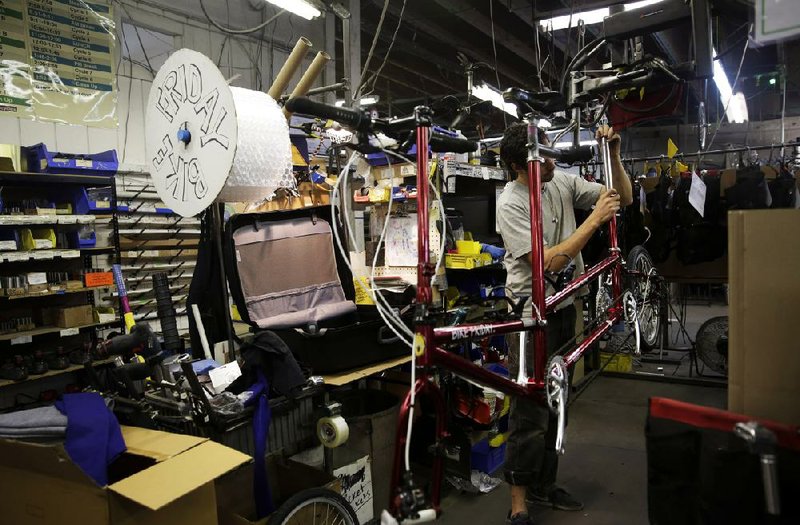WASHINGTON - U.S. manufacturing grew at a slightly faster pace in March compared with February as factory output recovered from disruptions caused by severe winter weather. Manufacturers also received more orders, suggesting that production could strengthen a bit in the months ahead.
The Institute for Supply Management, a group of purchasing managers, said Tuesday that its manufacturing index increased to 53.7 from 53.2 in February. Any reading above 50 indicates expansion.
The increase suggests that manufacturing is growing at a steady but modest pace after harsh winter weather caused a sharp slowdown in the first two months of the year.
Even so, factories are hiring at the slowest pace in nine months, the survey found. The government will release its official jobs report for March on Friday.
“The weakness we saw in the very early part of this year is going to abate and we’ll see better growth,” said Joshua Shapiro, chief U.S. economist at Maria Fiorini Ramirez Inc. in New York. “We’re making our way back to something that’s more sustainable.”
Manufacturing activity had plunged in January as snowstorms shut down factories and disrupted supply shipments. It rebounded slightly in February as orders and stockpiles grew. But a measure of production plummeted in February to a five-year low. That measure recovered all its losses in March.
The overall index remains below the level that prevailed in the second half of last year, when it regularly topped 56.
“There’s still some catching up to do,” said Jennifer Lee, an economist at BMO Capital Markets. “But at least it is heading in the right direction.”
The growth was broad based and many comments from manufacturers in the survey were positive. Fourteen of the 18 industries tracked by the index reported growth.
Other reports on manufacturing in recent weeks have been mixed.
Factory production jumped in February, according to a Federal Reserve report two weeks ago, as manufacturers cranked out more cars, home electronics and chemicals. Output grew by the most in six months. Still, the rebound came after a sharp fall in January.
Meanwhile, orders received by U.S. factories for durable goods were disappointing in February, the government said in a separate report. Orders rose 2.2 percent, but mostly because of greater demand for commercial aircraft, a volatile category. Excluding aircraft, autos and other transportation goods, orders rose just 0.2 percent.
And a key category that reflects business investment fell a steep 1.3 percent, the second setback in three months.
Last year, U.S. factories were cranking out appliances, autos and other goods at a healthy pace until harsh winter weather descended. The Institute for Supply Management’s index rose for six straight months until dipping slightly in December. That was followed by January’s sharp fall.
A second report Tuesday showed a slight increase in U.S. construction spending in February as a rebound in construction of hotels and other nonresidential buildings offset a decline in housing.
But housing construction fell as activity was still being depressed by the harsh winter.
Construction spending increased a scant 0.1 percent in February after a 0.2 percent drop in January, the Commerce Department said. The increase left construction at a seasonally adjusted annual rate of $945.7 billion, 8.7 percent above the level of a year ago.
The small increase in February came from a 1.2 percent advance in nonresidential projects, led by a 3.5 percent rise in construction of hotels and motels. Spending on government projects edged up 0.1 percent, helped by a big gain at the federal level. Residential construction dropped 0.8 percent, the biggest setback since July.
The increase in nonresidential construction was a rebound from January when spending in that area had fallen 1 percent. The February increase was helped by gains in spending on construction of lodging establishments, which offset weakness in office building and the category that includes shopping malls.
The 0.1 percent rise in public construction reflected a 5.8 percent rise in spending at the federal level, which offset a 0.5 percent decline in spending on state and local government projects. Even with the small February advance, government construction spending is down 1 percent from a year ago, in part because government projects have been restrained by tight budgets.
U.S. home prices rose in February from a year earlier at a solid pace, suggesting that a tight supply of available homes is driving prices up despite slowing sales.
Real estate data provider CoreLogic said Tuesday that prices for existing homes rose 12.2 percent in February from a year ago. That was up slightly from January’s year over-year pace of 12 percent.
On a month-to-month basis, prices in February rose 0.8 percent from January. But CoreLogic’s month-to-month prices aren’t adjusted for seasonal patterns, such as winter weather, which can depress sales.
Snowstorms, rising prices and higher mortgage rates combined to reduce home sales in February to their lowest level in 19 months.
A tight supply is helping boost prices even as sales slow. Sales fell 0.4 percent to a seasonally adjusted annual rate of 4.6 million in February from January, the National Association of Realtors said last month. That sales pace would exhaust the number of available homes in 5.2 months, the Realtors said - below the six-month supply typically available in healthy markets.
The states with the biggest price gains in the past year were California, where prices rose 19.8 percent, followed by Nevada, 18.5 percent, and Georgia, 14.2 percent. No states posted a drop in home prices.
Nationwide, average home prices remain 16.9 percent below the peak reached in April 2006, at the height of the housing bubble.
Information for this article was contributed by Christopher S. Rugaber and Martin Crutsinger of The Associated Press and Michelle Jamrisko of Bloomberg News.
Business, Pages 27 on 04/02/2014
